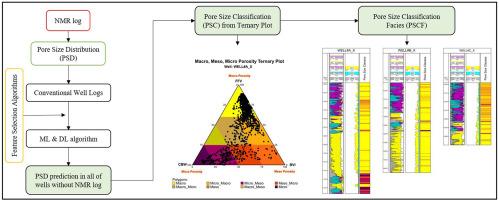在复杂岩性中利用测井记录和深度学习算法,基于储层流体体积分布进行孔隙尺寸分类和预测
IF 4.2
引用次数: 0
摘要
孔隙度分析在揭示储层行为及其与封闭流体的复杂关系方面起着举足轻重的作用。传统的孔径分布(PSD)预测方法依赖于钻井岩心或薄切片,面临着深度特异性的限制。在这项研究中,我们引入了一个创新框架,利用核磁共振(NMR)测井数据(包括粘土结合水(CBW)、不可还原结合体积(BVI)和自由流体体积(FFV))来确定三种孔径分布(微孔、中孔和大孔)。此外,我们还利用从 PSDs 得出的三元图建立了一个强大的孔径分类 (PSC) 系统。在所研究的三口井中,核磁共振测井数据仅适用于一口井(A 井),而常规测井数据则适用于所有三口井(A 井、B 井和 C 井)。这种区别使我们能够对其余两口井(B 井和 C 井)进行 PSD 预测。为了预测这些油井的 NMR 输出(CBW、BVI、FFV),采用了两步深度学习(DL)算法。首先,三种特征选择算法(f-classif、f-regression 和 mutual-info-regression)确定与 A 井 NMR 输出最相关的常规测井曲线。这三种特征选择算法利用统计计算。这些算法用于系统地识别和优化相关输入特征,从而在复杂的数据驱动工作中提高模型的可解释性和预测效力。因此,所有三种特征选择算法都将 4 个日志的数量作为 DL 算法的最佳输入数量,并为三种所需的输出分别引入不同的日志组合。随后,CUDA 深度神经网络长短期记忆算法(CUDNNLSTM)被用于预测 CBW、BVI 和 FFV 日志,该算法属于 DL 算法范畴,利用了 GPU 的计算能力。该预测利用了前一步中确定的最佳日志。首先在 A 井(80% 的数据作为训练数据,20% 作为测试数据)中对 NMR 输出进行估计。CBW、BVI 和 FFV 三项输出的实际数据与估计数据之间的相关系数(CC)分别为 95%、94% 和 97%,均方根误差(RMSE)分别为 0.0081、0.098 和 0.0089。为了评估所提出算法的有效性,我们将其与两种传统的对数估计方法进行了比较:多元回归和基于多分辨率图的聚类方法。结果表明,与这些传统方法相比,我们的算法具有更高的准确性。这种以 DL 为驱动的方法有助于根据 B 井和 C 井的流体饱和度预测 PSD。利用实际 NMR 测井(CBW、BVI、FFV)对 A 井中的七个不同 PSC 进行了和谐分类,同时利用三个预测测井对 B 井和 C 井中的等量 PSC 进行了和谐分类,从而确定了七个不同的孔径分类面 (PSCF)。由此产生的 PSCF 为生成精确、详细的储层三维模型提供了宝贵的见解。本文章由计算机程序翻译,如有差异,请以英文原文为准。

Pore size classification and prediction based on distribution of reservoir fluid volumes utilizing well logs and deep learning algorithm in a complex lithology
Pore size analysis plays a pivotal role in unraveling reservoir behavior and its intricate relationship with confined fluids. Traditional methods for predicting pore size distribution (PSD), relying on drilling cores or thin sections, face limitations associated with depth specificity. In this study, we introduce an innovative framework that leverages nuclear magnetic resonance (NMR) log data, encompassing clay-bound water (CBW), bound volume irreducible (BVI), and free fluid volume (FFV), to determine three PSDs (micropores, mesopores, and macropores). Moreover, we establish a robust pore size classification (PSC) system utilizing ternary plots, derived from the PSDs.
Within the three studied wells, NMR log data is exclusive to one well (well-A), while conventional well logs are accessible for all three wells (well-A, well-B, and well-C). This distinction enables PSD predictions for the remaining two wells (B and C). To prognosticate NMR outputs (CBW, BVI, FFV) for these wells, a two-step deep learning (DL) algorithm is implemented. Initially, three feature selection algorithms (f-classif, f-regression, and mutual-info-regression) identify the conventional well logs most correlated to NMR outputs in well-A. The three feature selection algorithms utilize statistical computations. These algorithms are utilized to systematically identify and optimize pertinent input features, thereby augmenting model interpretability and predictive efficacy within intricate data-driven endeavors. So, all three feature selection algorithms introduced the number of 4 logs as the most optimal number of inputs to the DL algorithm with different combinations of logs for each of the three desired outputs. Subsequently, the CUDA Deep Neural Network Long Short-Term Memory algorithm(CUDNNLSTM), belonging to the category of DL algorithms and harnessing the computational power of GPUs, is employed for the prediction of CBW, BVI, and FFV logs. This prediction leverages the optimal logs identified in the preceding step. Estimation of NMR outputs was done first in well-A (80% of data as training and 20% as testing). The correlation coefficient (CC) between the actual and estimated data for the three outputs CBW, BVI and FFV are 95%, 94%, and 97%, respectively, as well as root mean square error (RMSE) was obtained 0.0081, 0.098, and 0.0089, respectively. To assess the effectiveness of the proposed algorithm, we compared it with two traditional methods for log estimation: multiple regression and multi-resolution graph-based clustering methods. The results demonstrate the superior accuracy of our algorithm in comparison to these conventional approaches. This DL-driven approach facilitates PSD prediction grounded in fluid saturation for wells B and C.
Ternary plots are then employed for PSCs. Seven distinct PSCs within well-A employing actual NMR logs (CBW, BVI, FFV), in conjunction with an equivalent count within wells B and C utilizing three predicted logs, are harmoniously categorized leading to the identification of seven distinct pore size classification facies (PSCF). this research introduces an advanced approach to pore size classification and prediction, fusing NMR logs with deep learning techniques and extending their application to nearby wells without NMR log. The resulting PSCFs offer valuable insights into generating precise and detailed reservoir 3D models.
求助全文
通过发布文献求助,成功后即可免费获取论文全文。
去求助

 求助内容:
求助内容: 应助结果提醒方式:
应助结果提醒方式:


